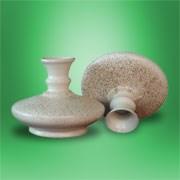
Indian ceramics and porcelain companies are increasingly leveraging the skills of local artisans for original handiwork and custom designs. In a market where the number of machine made products from factories in places like China are growing, Indian companies are channelling more resources towards research and development of quality designs. More specifically, some Indian ceramics studios are subcontracting to skilled women artisans who work from their homes. India artisans showcase their expertise in small decorative pieces and gift items.
India’s ceramic and porcelain crafts industry is leveraging local artisans’ strength in handwork and custom design to boost the line. Suppliers are confident this core advantage will sustain the sector amid the rise of machine-made models, including table- and kitchenware, and large items from China. They are directing R&D efforts toward intricate handicrafts and quality designs.
The limited output of craftsmen, each finishing only up to 100 pieces in a day, adds to the perceived product value. Unlike a number of international manufacturers with sizable factories, several India companies’ artists stay in their own ateliers.
Kuprkabi Ceramic Design Studio, for instance, subcontracts pottery to 110 skilled women who work from home. The maker specializes in OEM ceramic and terra cotta models such as gift items, home decor, tabletop accessories, mugs and lamps. It adopts new themes each season based on the latest trends.
The supplier will export to Europe and the US soon, having received inquiries from these markets and Russia, proprietor Vanmala Jain said.
Shristi Pottery likewise accepts buyers’ specifications for glazed and lead-free planters, pots, sculpture, oil diffusers, lamps and ashtrays in geometrical designs and leaf motifs. The company ships to Europe, the Middle East, East Asia and South America. The manufacturer intends to perform engobes and printing in coming months.
A number of suppliers apply surface treatment manually as well. One example is Chhatwal Ceramic Industry, which offers handpainted mugs, pots, beads and kitchenware. The maker exports oil lamps, and incense stick and candle holders to Sri Lanka. It plans to extend market reach to other locations.
In addition to artisanship, manufacturers are enhancing visual appeal through the use of various materials in ornamentation. They find clay’s decorative possibilities limiting at times, and its durability not satisfactory for certain applications.
In this regard, more makers are utilizing metal wires, leather and wood to create intricate designs. Themes are typically representative of the country, highlighting nature and ancient architecture.
Terra cotta flowerpot holders, wall murals, jewelry and small decorative pieces with metal and plastic adornments are the best-sellers.
The use of other materials is not purely for aesthetic purposes. Some models have layers made of ceramic and either steel or plastic for increased durability and functionality.
In aromatherapy and cooking pots, for instance, metal is employed to enable thermal transfer in the core, while ceramic covers the whole product to distribute heat evenly.
India thrives in handcrafted options, and is in fact the third-largest hub for ceramic and porcelain crafts, said Madhulika Dangwal, CEO of Shristi. The top two are Thailand and China. The latter location leads in machine-made versions.
India’s domestic market, which performed well in 2010, allows more room for price adjustments. This is because of a national preference for custom designs, as it is one of the places where pottery was first practiced.
http://www.globalsources.com/gsol/I/Ceramic-craft/a/9000000115136.htm
